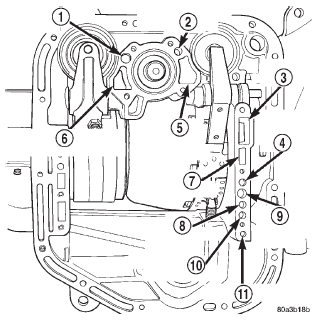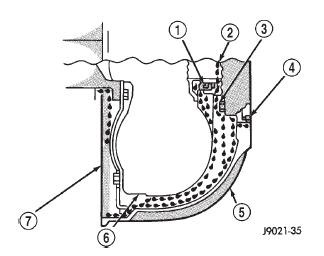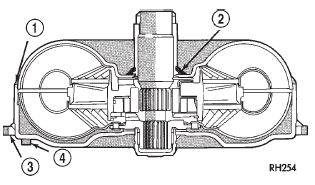Air testing transmission clutch and band operation. Converter housing fluid leak diagnosis
Air-pressure testing can be used to check transmission
front/rear clutch and band operation. The test
can be conducted with the transmission either in the
vehicle or on the work bench, as a final check, after
overhaul.
Air-pressure testing requires that the oil pan and
valve body be removed from the transmission. The
servo and clutch apply passages are shown (Fig. 67).
1 - REAR SERVO APPLY 2 - FRONT SERVO APPLY 3 - PUMP SUCTION 4 - FRONT CLUTCH APPLY 5 - FRONT SERVO RELEASE 6 - LINE PRESSURE TO ACCUMULATOR 7 - PUMP PRESSURE 8 - TO CONVERTER 9 - REAR CLUTCH APPLY 10 - FROM CONVERTER 11 - TO COOLER Front Clutch Air Test Place one or two fingers on the clutch housing and
apply air pressure through front clutch apply passage.
Piston movement can be felt and a soft thump
heard as the clutch applies. Rear Clutch Air Test Place one or two fingers on the clutch housing and
apply air pressure through rear clutch apply passage.
Piston movement can be felt and a soft thump heard
as the clutch applies. Front Servo Apply Air Test Apply air pressure to the front servo apply passage.
The servo rod should extend and cause the
band to tighten around the drum. Spring pressure
should release the servo when air pressure is
removed. Rear Servo Air Test Apply air pressure to the rear servo apply passage.
The servo rod should extend and cause the band to
tighten around the drum. Spring pressure should
release the servo when air pressure is removed. When diagnosing converter housing fluid leaks,
two items must be established before repair.
(1) Verify that a leak condition actually exists.
(2) Determined the true source of the leak.
Some suspected converter housing fluid leaks may
not be leaks at all. They may only be the result of
residual fluid in the converter housing, or excess
fluid spilled during factory fill or fill after repair.
Converter housing leaks have several potential
sources. Through careful observation, a leak source
can be identified before removing the transmission
for repair. Pump seal leaks tend to move along the
drive hub and onto the rear of the converter. Pump
O-ring or pump body leaks follow the same path as a
seal leak (Fig. 68). Pump vent or pump attaching bolt
leaks are generally deposited on the inside of the
converter housing and not on the converter itself
(Fig. 68). Pump seal or gasket leaks usually travel
down the inside of the converter housing. Front band
lever pin plug leaks are generally deposited on the
housing and not on the converter. TORQUE CONVERTER LEAK POINTS Possible sources of converter leaks are:
(1) Leaks at the weld joint around the outside
diameter weld (Fig. 69).
(2) Leaks at the converter hub weld (Fig. 69). CONVERTER HOUSING AREA LEAK CORRECTION 1) Remove converter.
(2) Tighten front band adjusting screw until band
is tight around front clutch retainer. This prevents
front/rear clutches from coming out when oil pump is
removed.
(3) Remove oil pump and remove pump seal.
Inspect pump housing drainback and vent holes for
obstructions. Clear holes with solvent and wire.
(4) Inspect pump bushing and converter hub. If
bushing is scored, replace it. If converter hub is
scored, either polish it with crocus cloth or replace
converter.
1 - PUMP SEAL 2 - PUMP VENT 3 - PUMP BOLT 4 - PUMP GASKET 5 - CONVERTER HOUSING 6 - CONVERTER 7 - REAR MAIN SEAL LEAK
1 - OUTSIDE DIAMETER WELD 2 - TORQUE CONVERTER HUB WELD 3 - STARTER RING GEAR 4 - LUG (5) Install new pump seal, O-ring, and gasket.
Replace oil pump if cracked, porous or damaged in
any way. Be sure to loosen the front band before
installing the oil pump, damage to the oil pump seal
may occur if the band is still tightened to the front
clutch retainer.
(6) Loosen kickdown lever pin access plug three
turns. Apply Loctite 592, or Permatex No. 2 to plug
threads and tighten plug to 17 N*m (150 in. lbs.)
torque.
(7) Adjust front band. (8) Lubricate pump seal and converter hub with
transmission fluid or petroleum jelly and install converter.
(9) Install transmission and converter housing
dust shield.
(10) Lower vehicle.Air testing transmission clutch and band operation
 Fig. 67 Air Pressure Test Passages
Fig. 67 Air Pressure Test PassagesConverter housing fluid leak diagnosis
 Fig. 68 Converter Housing Leak Paths
Fig. 68 Converter Housing Leak Paths Fig. 69 Converter Leak Points-Typical
Fig. 69 Converter Leak Points-Typical
Dodge Durango (DN) 1998-2003 Service Manual
- Lubrication and Maintenance
- Suspension
- Differential and Driveline
- Brakes
- Cooling System
- Battery
- Starting Systems
- Charging System
- Ignition System
- Instrument Panel Systems
- Audio Systems
- Horn Systems
- Speed Control System
- Turn Signal and Hazard Warning Systems
- Wiper and Washer Systems
- Lamps
- Passive Restraint Systems
- Electrically Heated Systems
- Power Distribution System
- Power Lock Systems
- Vehicle Theft/Security Systems
- Power Seat System
- Power Window Systems
- Power Mirror Systems
- Chime/Buzzer Warning Systems
- Overhead Console Systems
- Engine
- Exhaust System
- Frame and Bumpers
- Fuel System
- Steering
- Transmission and Transfer Case
- Tires and Wheels
- Body
- Heating and Air Conditioning
- Emission Control Systems
- Introduction
